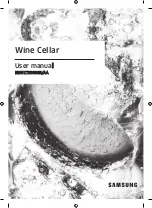
UM.02 ENOLINE WINE CARD
Page 10 of 46
Rev 08, May 2010
8.
Check that the pressure on the low pressure gauge is correct= 4 bar. Also
check every 6-7 days the pressure of the cylinder.
9.
When the tank is almost empty and change is required, close all inlets and
outlets and pull the safety valve ring to discharge residual pressure; loose
manometer bolt and replace the tank.
6.4
Water Drainage
Enoline Temperature Controlled
models only
A condensate drain tube (10mm O/D) must be
connected into the back of the temperature
controlled enoline models and discharged to a
permanent drain or into a bottle that is emptied
regularly.
7
Operating Instructions
Turn on the power.
Switch on main black switch and two secondary switches (for temperature
controlled enoline only).
7.1 Inserting the Bottle Tube
Insert the Bottle Tube into the centre of each Tap by pushing it firmly to create
a secure fit (pic A).
PIC A
PIC B
The Bottle Tube has a filter (pic B) to prevent sediment from red wines entering
the Tap valve. The Bottle Tube should extend to the bottom of the bottle.
However, for heavy sediment red wines, it is recommended to cut the
tube shorter, in order not to reach the bottom of the bottle; this is to avoid the
sediment entering the tap.
7.2 Loading the Bottle
Open the bottle, remove any eventual foreign object from bottle neck upper
part and slide the Bottle Tube inside the bottle while lifting the bottle towards
the tap. Place the bottle on the piston (pic C). Insert a Technical Card (*) into
the slot and firmly press the central button above the bottle you desire to
engage. The maximum bottle size is 360mm high. The Enomatic model is
supplied with plastic packers below the bottle piston covers. These packers can
be removed to fit the tallest bottles, or added to fit shortest ones.
PIC C








































